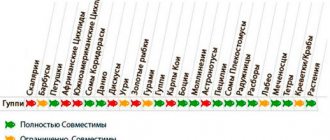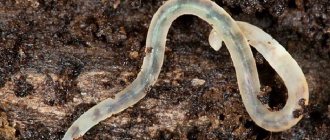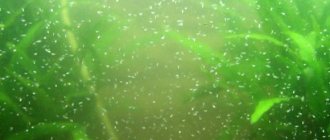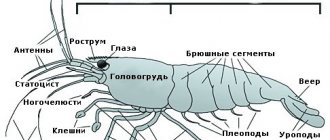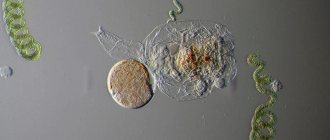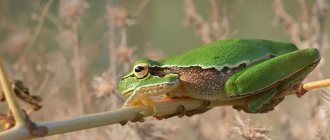The common tubifex is a popular live food for fish. Habitat: standing waters with a clayey and especially sandy bottom. Externally, the threads appear red, which is facilitated by the high concentration of iron in the blood. The size of individuals ranges from 1 to 8 centimeters. A specific condition for their life is pollution with organic matter. They are rightfully considered living indicators of environmental quality.
Tubifex habitats
Worms of this species form colonies in the soil located at shallow depths. Individuals create improvised “tube-cells” from a mixture of substrate and the mucus they produce.
The tubifex is attached to them, and the free edge produces wave-like movements (while the mouth is immersed in the ground). Its main functions:
- ingestion of nutrients;
- filtration;
- mucus production.
Worms feed on organic matter, mainly decay bacteria. They are capable of accumulating substances toxic to fish in their tissues. Therefore, the reservoir chosen for capture should be located away from large industrial facilities and sewers. The best option would be lakes outside the city.
Description and natural habitat
Thread-like worms of the Malochaete species grow up to 40 mm in length and have a characteristic pinkish color. Each body segment contains 4 bristles.
The diet consists of particles of organisms and flora decomposing in the water. The feeding process occurs by ingesting sludge and passing it through the intestines.
The Tubifex lives everywhere, in stagnant silted reservoirs, rivers and streams. It thrives especially well in polluted waters and creates significant colonies in the bottom silt. Less common in sandy and rocky soils with clear flowing liquid.
It forms a hole at the bottom, from which it exposes the back of the body with gills. The peculiar tail makes constant rotational movements that help to breathe. Not afraid of frost, active all year round. It reproduces sexually, laying eggs in special cocoons. Tubifex worms are hermaphrodites.
Photo gallery of Pipemakers:
In nature, it is a carrier of parasites, so before feeding the fish it is processed and kept in quarantine for a week. The Tubifex dosage is strictly observed; pets are given exactly as much as they can eat. When one sexually mature individual gets into the ground, an entire colony can develop.
Method of catching the common tubifex
The fishing method is selected based on the required amount of live food:
- Using a net and bait. Lower a net to the bottom of the reservoir, in which spoiled fruits, pumpkin pulp, and carrot peelings are placed.
- A shovel or scoop will allow you to catch a large number of tubifex at once.
| Stage | Description |
| Catching the species | Scoop up the top layer of soil along with the worms. |
| Filtration and settling of the mixture | Let the mixture sit for several hours and drain off the settled water. Spread a layer of sludge on cheesecloth. |
| Heating | Take a cloth with sludge and place it over the container from which the steam is emanating (pan, bucket, bowl). The tubule maker is activated by temperature exposure. |
| Collection of individuals | Place the resulting ball on a frame (wooden, made of wire with stretched fabric) and sprinkle with water. Worms live only in moist environments. |
Where to begin?
Under natural conditions, tubifex worms breed and live in stagnant bodies of water with a muddy or sandy bottom. These are thin worms, 4 to 10 cm long, pinkish or red in color, due to the large amount of hemoglobin they have in their blood. The hemoglobin and proteins make them a very useful food for fish. At the bottom, the tubifex is capable of forming entire colonies all year round, feeding on decaying organic matter.
In order to start a business in breeding tubifex worms, you first need to obtain several individuals in natural conditions. To do this, you need to take a net or sieve, go to a pond and scoop up the bottom silt. The contents of the net are laid out on gauze and placed in a container of water. Soon the worms will crawl through the gauze and gather in balls. Now they need to be placed in another container with a small amount of warm water.
Feeding fish with tubifex
When buying live bait at a pet store, pay attention to the water in which they are located: it must be clean. Very often, when growing worms for commercial purposes, producers neglect the maintenance conditions.
Breeding tubifex in wastewater indicates that it feeds on manure and harmful bacteria. This makes it a source of fungal infections, tuberculosis and infection with various parasites.
Before feeding, place the tubifex in a container of dechlorinated water and rinse thoroughly several times.
A way to check the freshness of complementary foods: poke your finger into a lump of worms: they should shrink sharply. This indicates its suitability as complementary food.
The serving size depends on the number of fish in the aquarium: it should be eaten within five minutes. The best option would be a special feeder, which can be purchased at a pet store. This is a plastic frame with a mesh attached to it. Its main task is to prevent the worms from immediately falling to the bottom.
When the tubifex reaches the substrate, it burrows and establishes a cell. Soon the individual dies and, decomposing, silts up the aquarium. Therefore, after feeding, remove any remaining food using a net.
Using this food requires following the basic feeding rule - do not overfeed.
You should not feed your fish exclusively with tubifex. In large quantities, it can lead to obesity and vitamin deficiency; the fish will become inactive and will soon die. Therefore, it is better to alternate it with other types of food.
The vitamin complex will be a good addition to complementary foods. Add vitamins to the container with tubifex in a ratio of 0.25 grams per 100 grams of worms.
Do you feed your fish with tubifex?
Not really
Storage and types of prepared feed
You can use more than just the entire worm. It is served sliced or minced. It is permissible to freeze food; its nutritional properties are retained in full.
Fresh Tubifex are kept in low tanks with clean water; the liquid should be poured to the bottom without covering the colony. Be sure to rinse the food several times a day. Storage in the refrigerator (without freezing) is acceptable for 2 months.
Excess that is not eaten by fish is removed from the tank as quickly as possible to avoid water pollution and disruption of chemical indicators due to the process of decomposition of organic matter.
Ways to protect your fish from possible diseases
Always pay attention to the appearance of the worms. They should be:
- rich color;
- no repulsive odor;
- mobile.
Disinfecting complementary foods will help avoid many diseases. To do this, before feeding, dip the worms in a weak solution of potassium permanganate, soak them in water for several hours and rinse them under running water several times.
Frozen tubifex poses an increased danger; it is better to treat it with antibiotics. You can purchase them at any pet store or veterinary pharmacy. Experienced aquarists advise soaking tubifex in preparations with bifidobacteria. Also, this kind of microorganisms are found in fermented milk products. This complementary food will be beneficial for the fish’s intestines.
You can use a rinse for disinfection in the form of a 5% solution of table salt.
Although the tubifex is unpretentious, it does not like chlorinated water (it may die); you need to use distilled or settled water.
Tubifex cultivation as a direction of aquaculture
Tubifex in a Petri dish With the expansion of the aquaculture industry, many alternative feeds that are inexpensive to produce are being explored. Farmers need adequate spawning feed especially for fish species like Ompok spp., Mystus spp., Pangasius spp., Clarias spp. and others, as well as Anabas spp. (creeperfish), Channa spp (snakehead). The use of the tubifex tubifex worm as live food for larvae has long been practiced on farms. Behavioral studies have shown that catfish instinctively prefer to accept those food objects that exhibit motor activity. The larvae are thought to be visually perceptive and adapted to capture moving prey. In addition, the movement of live food likely stimulates larval feeding responses.
Ornamental fish are usually fed with tubifex. This worm is a valuable food item in freshwater intensive aquaculture worldwide due to its high caloric content. Remarkably, Clarius batrachus larvae fed on tubifex had higher survival rates and ten times greater growth than those fed prepared fry food. In these circumstances, efforts should be made to develop technology for obtaining a reliable supply of tubifex on an industrial scale to support aquaculture, at least for catfish and ornamental fish farming.
Content
Fish farming and food
Ornamental fish aquaculture is recognized as an important trade industry internationally. Cultivation of catfish, snakehead and slider fish is widespread and these species are particularly present in Indian markets. Sounded fish are now in demand due to nutritional value, less bones, consumer preference and easy digestibility. Growing consumer demand for them has attracted the attention of farmers to their large-scale production. Nowadays, aquaculture is also developing towards the cultivation of these fishes, as having significant nutritional properties, they are easily processed into various value-added products and food products through the process of fortification. Fish farmers are also aware of their commercial value. Farmers need two basic elements for aquaculture of these species: (i) quality larvae and (ii) suitable feed for rearing the young. Tubifex is one of the preferred live foods.
View of rectangular fiberglass tanks used for tubifex cultivation
Tubifex harvest
Why cultivate tubifex?
The tubifex naturally lives in running water, especially in sewage canals and open drains. Until now, tubifex worms were supplied after being collected from such habitats. In the summer, most of the open drainage dries up, and the tubifex becomes scarce, and the market price becomes so high that ordinary farmers cannot afford to purchase it. There are also some problems in collecting tubifex from the natural environment: (i) collection is the most labor-intensive task; skilled workers may collect from a difficult-to-reach area with the risk of skin infection, (ii) worms may be contaminated, and (iii) there is the possibility of transmission of the fish pathogen from sewage canals. Captive production of tubifex is necessary to meet demand, ensure a reliable supply, and protect the health of humans and animals.
The tubifex worm is also known as the sludge worm because it naturally lives in sludge containing organic matter. It is distributed in a variety of habitats and has a high level of biological oxygen demand. However, its survival is ensured by high endurance, since this organism can withstand very low oxygen concentrations. On the other hand, there are many wastes and by-products generated by agricultural industries. This waste, along with cattle manure, comes in huge quantities from dairies, rice mills, distilleries, breweries, food processing plants, etc. There is ample opportunity to use this waste as a substrate for tubifex. In itself, tubifex cultivation provides excellent opportunities for recycling this waste.
Cultivation procedure
Growth rate (kg/m-2/day-1) of tubifex biomass feeding on various wastes during 10-, 20-, 30-day cultivation
Selection of waste for tubifex cultivation
The wastes were selected on the basis of easy availability and ease of transportation from the production facilities to the Regional Research Center of the Central Institute of Freshwater Aquaculture in Kolkata. Fresh cattle manure, dairy waste and rice mill waste were collected and transported to the center's wet environment laboratory. Known as a suitable organic manure traditionally used in aquaculture, fresh cattle manure has been used as a food resource after decomposition in water.
In the experiment, milk sediment was considered as a potential food resource. After processing various dairy products, the resulting waste is drained and stored in a large container in direct sunlight to avoid contamination. The semi-solid substance stored in oxidized milk waste is collected from Metro dairies.
Waste from rice mills is used as organic fertilizer in rice fields. In rice mill factories, wastewater is generated after boiling the rice grains. Wastewater is discharged into swampy areas for temporary storage. Organic substances from wastewater do not settle, resulting in a thick layer of dark brown substance floating on the surface, which was used in the experiment.
Experimental project
To conduct the experiment, three separate time periods are provided - 10, 20 and 30 days. Fresh cattle manure, dairy waste and rice mill waste were tested at appropriate time periods, each carried out three times. A total of nine fiberglass pools were installed for each time period, with testing initially carried out during the first period of 10 days, followed by 20 and 30 days. Each pool (2.4 m x 0.67 m x 1.0 m) is manufactured in a specific design with both inlet and outlet equipment. The inflow systems are made with an opening on the side of the tank, while the outflow system is made at the bottom on the opposite side. The outflow hole was raised to a height of 10 cm with a plastic pipe of the required size attached to it. The supply system is connected to a common PVC pipeline and an individual control valve to control water flow. Water was initially supplied at a rate of 0.75 liters per minute to avoid erosion of the underlying media, and then continuously increased to 1.2 liters per minute.
Tubifex harvest
Basic medium, inoculum and nutrients
The bottom of each basin was covered with soil sludge containing sand, silt, clay and organic manure. The soil sludge used as the base medium was sieved through a fine nylon mesh to remove coarse and uneven matter and compacted to a thickness of 2.0 cm. 100 g of tubifex, 62.5 g per square meter, was evenly inoculated into each fiberglass basin , covering its entire area. Waste was added as feed to each tank two hours after the inoculum was added. Each waste (on a dry weight basis) was applied at a rate of 4.0 grams per 1.0 gram of worms daily. 4.0 kg (4 g waste × 100 g inoculum × 10 days) of each waste was used for each stage in a 10-day culture. However, for the 20- and 30-day culture, the amount of feeding waste was adjusted every ten days based on tubifex sampling.
Tubifex harvest
Tubifex was collected after the indicated time periods. The water from each pool was drained through an outflow system. The basic medium was divided into five or six parts. The entire contents of each part were placed in a nylon net and washed with water. In the process, the base medium was sieved through a nylon mesh, leaving the tubifex biomass inside. The biomass was then collected and placed in a beaker filled with fresh water. This process was continued until all biomass was collected from each tank.
Evaluation of the pilot project
The production of tubifex biomass in all three cultivation variants was significantly (P<0.05) different. Net biomass production in all three experiments showed that rice mill waste had the highest efficiency, with dairy waste coming in second and fresh cattle manure coming in last. The most effective cultivation period was found to be 20 days for both dairy and rice mill waste feeding (P<0.05), resulting in the highest amount of biomass. After this, the growth rate under the same conditions decreased, which was recorded during the 30-day cultivation period. Compared with other cultivation periods, the growth rate when feeding raw cattle manure after 20 days of cultivation was the lowest (P < 0.05), but 30 days of cultivation was the most effective for this type of feeding (P < 0.05).
Component composition of tubifex after cultivation
The component composition (% by weight) of the collected tubifex worms showed that when fed waste from rice mills, the worms contained the highest amount of protein (6.38), crude fat (3.02) and minerals (2.98). This was followed by worms fed dairy waste (protein 5.87, crude fat 1.29, minerals 2.58) and fresh cattle manure (protein 4.02, crude fat 0.85, minerals). substances – 2.43).
Suitable waste for cultivating tubifex according to the results of the experiment
Various workers have been cultivating tubifex using mustard cake, wheat bran, soybean meal, lettuce and cow dung. All these resources used as nutrients for tubifex cultivation have a high market price and need to be purchased. Most fish farmers are interested in purchasing inexpensive inputs that are easily available. Farmers have difficulty when any input used to grow fish is expensive. However, both milk waste and rice mill waste are readily available in large quantities from their respective manufacturing units and are also recognized as effective food products for tubifex production. The use of waste is economically profitable, as it does not require foreign exchange transactions.
Duration of tubifex cultivation based on the results of the experiment
The tubifex is considered one of the main types of food. The duration of cultivation is an important factor to obtain the desired product in the optimal quantity over the required period of time. In the experiment carried out, cultivation for 20 days is the ideal period to obtain optimal tubifex production, provided that waste from dairy products and rice mills is used as food for the worms. In comparison with other periods of tubifex cultivation, the tests carried out show that despite the reduction in the number of days for cultivation, especially when feeding waste from dairy products and rice mills, the best result is achieved. Longer cultivation periods may result in lower growth rates. A shorter duration provides benefits such as less time required for management in the production system, along with other ongoing costs.
Conclusion
Tubifex is an important food for raising young fish. Tubifex should be produced using suitable methods that are economically feasible. For such a production system, two important issues to consider are the availability of resources used as food for biomass production (poultry manure and other by-products can be tried, provided they are available in sufficient quantities and are non-toxic) and the short duration of cultivation, which is important for minimizing labor use and reducing risks, as well as maximizing yields and saving water and energy. —— R. N. Mandall, S. Kar, P. P. Chakrabarti, D. N. Chattopadhyay, B. N. Paul, S. Adhikari, J. Maity and B. R. Pillai. Production of tubifex is a new dimension of aquaculture in feeding juvenile fish. Aquaculture Asia. 2018
How to store worms
Timely washing can keep the tubifex alive for up to two months. To preserve all the beneficial properties, store it in a thin layer of water. It is best to take a piece of cloth, wet it, and lay the worms on top. Place live food in a shallow container. An acceptable temperature is 5-10 degrees, which can be achieved using a refrigerator.
When washing, remove dead worms: worms that feel well instantly curl into rings and tend to form lumps. Such worms are suitable for consumption.
Freezing live food will make storage much easier. The tubifex in this form still retains its beneficial properties for six months.
Before freezing worms, remove dead worms, debris, and possible waste products. Spread them in a thin layer or in a form convenient for you.
Social structure and reproduction
Photo: Common tubifex
Tubifex worms are not able to regenerate lost body parts and do not split into two or more parts to form two or more individuals. They are not asexual; these creatures reproduce sexually. The genital organs are located near the ventral part of the body.
Interesting fact: Tubifex worms are hermaphroditic: each individual produces both a sperm and an egg, and during mating, a pair of individuals fertilize each other's eggs.
Mature tubifex worms have a clitellum, a ring-shaped or saddle-shaped stripe towards the front of the body (earthworms have the same structure). The clitellum surrounds about 2 or 3 body segments, including the segments that produce eggs and sperm, and secretes a mucous cocoon that protects the fertilized eggs until they hatch. Tubifex worms do not have a separate larval stage; the young are simply small and immature. As they grow, their length increases by forming new segments just before the very last section.
After copulation, which involves the transfer of sperm between two individuals, the sperm is stored in sacs located behind the female reproductive opening. These fertilized eggs are then arranged like a cocoon. The eggs in the cocoon develop within a few days of being laid, and the worm's development is complete and it becomes a fully functioning worm.
Is Tubifex necessary in the diet?
Tubifex is a universal and very nutritious complementary food for most fish species. It is a natural source of protein (about 45%). Worms contain essential amino acids and vitamins, but a sufficiently high calorie content can lead to rapid obesity.
The hemoglobin in the composition will help strengthen the fish’s immunity. The tubifex promotes successful spawning and provides the female with additional useful substances. When preparing a diet, it is worth considering that the weak stomach of some individuals may not be able to cope with such heavy food.
Weekend feed
Tubifex is often called "weekend fish food." The fact is that if there is powerful filtration and aeration in the aquarium, then it is allowed to place a large number of tubifex worms into the reservoir. Even if the worms settle to the bottom, they will quickly be carried away by the current. It is only important to maintain certain temperatures in the artificial reservoir, not exceeding +25°C, in order to avoid possible reproduction.
Thus, if it is necessary to go somewhere for a few days, the owner of aquarium fish will not have to worry about them going hungry or asking neighbors to feed their pets. It is enough to simply put several portions of tubifex into the aquarium at once, for several feedings.
Tubifex is an excellent live food option for aquarium fish. Even though it does not contain a large amount of vitamins, when introduced into the diet as an additional ingredient, it provides fry and small fish with proteins, promotes their rapid growth and full development.
Breeding tubifex at home
Breeding requires certain skills from the aquarist. Prepare a special soil: mix garden soil with dry moss, add a decoction of rice and wheat. Place the finished substrate in a warm place for at least two days. Nutrient bacteria must develop in it.
After this, place the tubifex worms in the soil and irrigate regularly with clean water. Change it at least once a week. So, 15-20 cm3 of earth is enough for a month, after which the composition needs to be updated.
Breeding and extraction methods
To grow Tubifex at home, prepare a special soil mixture consisting of garden soil, ground moss and wheat and rice steamed in milk. Add a teaspoon of cereal to 0.5 liters of liquid and boil the mixture for 20 minutes. This will be a nutrient mixture for the worm. All components are mixed and cleaned and quarantined individuals are placed into it. For their comfortable living and rapid reproduction, a compressor is installed in the container, the water temperature is room temperature, the minimum depth is no more than 10 cm, taking into account the thickness of the soil with a density of 5-7.
A colony that creates visible movements of bottom silt is considered to be sufficiently developed.
To quickly clean the feed, it is better to use the thermal method, that is, heating the soil in a nylon stocking or gauze. Then the colony quickly leaves the danger zone, swimming into clean water.




